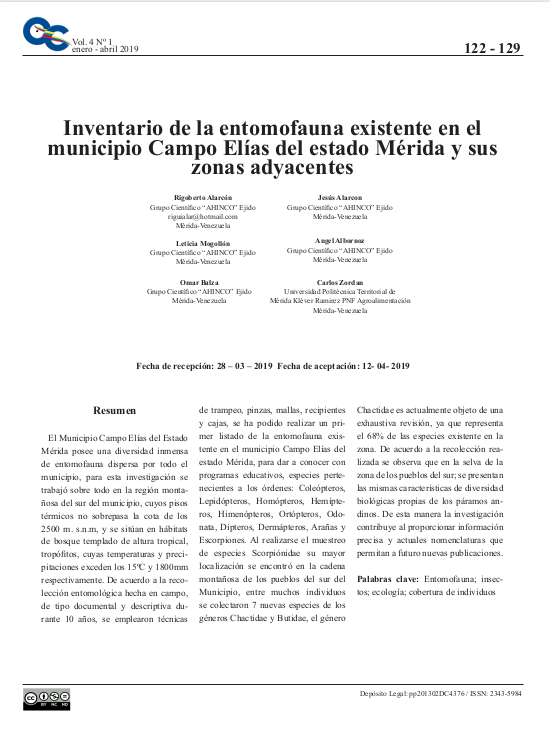Inventory of the existing entomofauna in the Campo Elías municipality of Mérida state and its adjacent areas
Keywords:
Entomofauna, insects, ecology, coverage and individualsAbstract
The Campo Elías Municipality of the Mérida State has an immense diversity of entomofauna dispersed throughout the municipality, for this research work was mainly carried out in the mountainous region of the south of the municipality, whose thermal floors do not exceed the elevation of 2500 m. s.n.m, and are located in temperate forest habitats of tropical height, trophophytes, whose temperatures and precipitations exceed 15ºC and 1800mm respectively.According to the entomological collection made in the field, documentary and descriptive for 10 years, trapping techniques, tweezers, meshes, containers and boxes were used, it was possible to make a first list of the existing entomofauna in the Campo Elías municipality. Mérida state, to make known with educational programs, species belonging to the orders: Coleoptera, Lepidoptera, Homoptera, Hemiptera, Hymenoptera, Orthoptera, Odonata, Diptera, Dermápteros,, Spiders and Scorpions.When the Scorpionidae species were sampled, its greatest location was found in the mountain range of the towns of the south of the Municipality, among many individuals 7 new species of the genera Chactidae and Butidae were collected, the genus Chactidae is currently subject to a exhaustive review, since it represents 68% of the existing species in the area. According to the collection made it is observed that in the jungle of the zone of the southern towns; the same characteristics of biological diversity characteristic of the Andean páramos are presented. In this way the research contributes by providing accurate information and current nomenclatures that allow future new publications.
Downloads
References
M. A. González Sponga. (1987). Arácnidos de Venezuela, Opiliones Laniatores I, Familias Phalangodidae Y Agoristenidae. Academia de Ciencias Físicas, Matemáticas y Naturales. Volumen XXVI. Instituto universitario Pedagógico de Caracas. Caracas. Venezuela.
M. A. González Sponga.(1987). Arácnidos de Venezuela, Opiliones Laniatores II, Familia Cosmetidae. Instituto universitario Pedagógico de Caracas. Caracas. Venezuela.
M. A. González Sponga.(1996). Guía Para Identificar Escorpiones de Venezuela. Cuadernas Lagoven. Caracas. Venezuela.
M. A. González Sponga.(1996). Guía Para Identificar Escorpiones de Venezuela. Cuadernas Lagoven. Caracas. Venezuela.
Molina M.R & R.J Vergara (1997). Estimación preliminar de la disponibilidad y demandas de agua en la cuenca alta del Rio Chama, Municipio Rangel. Mérida Venezuela: Trabajo especial de grado. Universidad de los Andes.
Pérez, J. (2012). Diccionario Entomologico Venezolano. Instituto Venezolano de Investigaciones Científicas. Caracas, Venezuela.
Sarmiento G, M. Monasterio, A. Azocar, E. Catellano y O. Silva (1971). Estudio integral de la cuenca de los ríos Chama y Capazón, vegetación natural. Mérida Venezuela: Universidad de los Andes e Instituto de Geografía y conservación de recursos naturales.
Vivas, L. (1992). Los Andes Venezolanos, Academia Nacional de Historia. Caracas.

Downloads
Published
How to Cite
Issue
Section
License

This work is licensed under a Creative Commons Attribution-NoDerivatives 4.0 International License.







